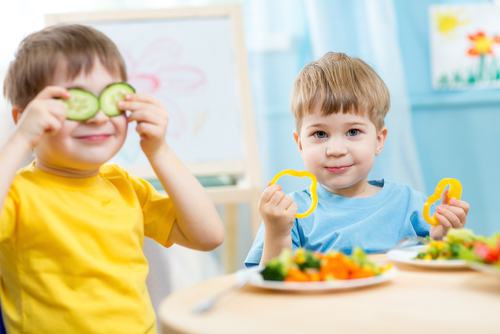Sugar is exposed to our children at a very young age. A great deal of the sugars we consume today are hidden in many of the packaged and processed foods we purchase, not usually seen as sweets. Not only does this present a problem for added sugar consumption, but society tends to associate children with sweetness. However, the association we make is generally with cake, candy, ice cream, and other sweet treats rather than the sweet tenderness that childhood brings.
Everywhere we go, children seem to be a magnet for the sweet substance. Treating your child to an ice cream once in a while is certainly fun and very much enjoyable for the whole family; however sadly, this day in age treats have become a part of our society’s modern day diet.
Children, Nutrition and The Sugar Plague
According to WHO (World Health Organization), children and adults should limit their sugar intake to no more than 25 grams (6 tsp) per day to prevent illness and provide health benefits. Since there has not been any reported evidence of adverse affects from consuming the naturally occurring sugars in fresh fruits and vegetables, they are not referred to in the WHO guidelines. Let’s take a quick look at a few common things that are offered and/or marketed for children and the sugar intake per serving.
Item Sugar Content/serving
Ketchup 1tsp or 4 grams
Can of Pop/soda 10tsp or 40 grams
Fruit by the foot 2tsp or 10 grams
Granola bar 4.4tsp or 22 grams
Fruit loops (1 cup) 2.4tsp or 12 grams
Apple juice (1 cup) 4.8tsp or 24 grams
Adding all of this up, it would equal 24.6 teaspoons or 112 grams of free sugars in one day! You would never spoon feed your children sugar right out of the bag would you? My guess is probably not. There is no difference between hidden and free sugar; at the end of the day it all adds up to the same amount of consumption.
Sugar addiction sets in very quickly, even for children. Researchers indicate that sugar and the sweet taste can stimulate the brain by activating beta endorphin receptor sites which are the very same chemicals activated by the use of morphine and heroin. Dopamine, which is our feel good hormone, is also stimulated by sugar. It is released and plays a major role in reward-motivated behavior such as drug use, gambling and sex.
This type of dopamine stimulation and chemical reward that we obtain from fulfilling food cravings has been compared to drug addiction. Personally, I find it very scary that sugar addiction doesn’t fall too short of drugs, alcohol and gambling; in addition, comes with its own withdraw symptoms that can be extremely uncomfortable and last for three to four weeks.
Sugar has been implicated in various health problems such as, tooth decay, psychological problems including ADHD-now one of the most common child diagnosis; emotional problems, stress and burnout syndromes, anxiety and type 2 diabetes. Although this list is not complete, it gives a good indication of adverse reactions related to refined sugar consumption. Sugar is a breeding ground for viruses, bacteria and infection. These microorganisms LOVE sugar, causing the immune system to weaken and to prolong any healing processes.
Children need a balanced diet consisting of real, whole foods for every area of development. It is vital for good health and wellbeing. This includes fresh fruits and vegetables, nuts, seeds and whole grains. However, whole grain does NOT include cereals and other processed foods. Reading labels are vitally important in choosing the right foods for you and your family. Be careful with the popular marketing claim, “whole grain.” Anything made with refined white sugar with just a small amount of whole wheat added back in, can be listed as “whole grain.” Look at the ingredients list and watch for “whole wheat flour” to be the first on the list. Another one is “multigrain.” This has no proven health benefits, particularly if all those grains are refined.
Sugar is a nutrient depleting substance and a child who consumes a lot of sugar in their diet or who does not have a balanced diet may benefit greatly from supplementation of multivitamins. When supplementing, it is important to choose a quality vitamin since many on the shelves include various fillers and additives such as added sugars or artificial sweeteners, colors and other synthetic ingredients. It is recommended to discuss supplementation further with your physician, naturopath, or nutritionist.
Some Hidden Names for Sugar
- Inulin
- Glucose-fructose
- Syrup
- Iso glucose
- Chicory
- Corn syrup
- Fruit fructose
Be careful of the items labeled, “sugar free!” This is another great marketing tool. Chances are, what your buying is sweetened with something artificially and/or chemically made, such as aspartame (NutraSweet), sucralose (splenda), or saccharin (sweet and low). Although deemed as safe for human consumption, research has indicated otherwise.
In my home, I reach for stevia or honey to sweeten our foods. Extensive research has been provided on stevia with no adverse affects. For this reason, this is my “go-to.” I’ve also used xylitol (derived from the root of birch trees) on the rare occasion, however it is a sugar alcohol and some people have experienced gas and/or bloating after consuming.
Food provides our bodies with energy, protein, healthy and essential fats AND the vitamins and minerals we need to live, grow and function properly. Infancy to school age, parents are the single most important role models for their children. Teaching children at a young age to make good food choices, exercise, and take care of their bodies will build the foundation of good health and wellness as they grow.


